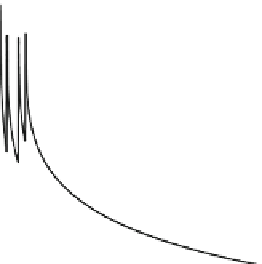Information Technology Reference
In-Depth Information
Fig. 5.11 Massed versus
distributed practice in relation
to time to learn a list. Given
exponential decay, which is
often assumed for memory,
the solid line shows a given
amount of practice as one
block, and the dashed line
shows the same amount
spread out over a longer
period. The distributed
practice has higher activation
after the second practice, and
will for the remainder of the
curve
10
Massed
Distributed
1
0
0
1,000 2,000 3,000 4,000 5,000 6,000 7,000 8,000 9,000 10,000
Time (arbitrary units)
what they had learned from the old interface to the new interface. Only the key
bindings changed; the underlying approach and the command structures did not, so
the users were able to apply most of what they had learned. Another similar example
is that users seem to prefer mice over light pens, even though the light pens were
faster to use (Charness et al.
2004
).
Another way to represent learning is with the implicit/explicit distinction.
Implicit learning seems to be automatic, is based on practice, is not improved by
reflection, and produces knowledge that cannot be verbalized. This might be
roughly equivalent to the rule tuning stage. If the rules are created based on a
simple domain theory, but a more complex domain exists, then additional learning
can occur.
Explicit learning proceeds with full consciousness in a hypothesis testing way;
it produces knowledge that can be verbalized. This is examined in more detail in a
later section on problem solving.
These distinctions become important when teaching users how to use an
interface. Some information is reported to them as declarative knowledge to be
learned (where things are, who other users are, and what are the objects), and some
information consists of procedural skills such as how to do a task.
Learning can be massed or distributed. Massed refers to learning that occurs at a
single time, for example, cramming for a test. Distributed learning occurs with
breaks in time between the learning episodes. Figure
5.11
shows how much better
distributed learning can be. Distributed learning takes less total time (sometimes
one-third of the time), and the retention is better, sometimes 50% better. Anything
you can do to assist your users to learn in a distributed fashion will help their
learning. Some interfaces now put up hints, which appears to be a way to support
distributed learning.























Search WWH ::

Custom Search